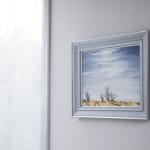Yokoyama Misao (1920–1973)
Mackerel Sky
Color, gold, and silver on paper, framed (15M)
With a label signed by the artist
Seal: Yama
46 x 65.5 cm
66.5 x 85.5 cm (overall)
Further images
Although there is no clear indication, the scenery in the present work might be associated with the nearby riverbank in Niigata, Yokoyama Misao’s intimate hometown, or somewhere unknown in the boundless land of Hokkaido. Shimmering in the sun, a few trees at the riverbank stand out strikingly; above, the cirrocumulus clouds stretching horizontally convey an air of tranquility. The pigments applied on the bank appear to be a mingling of gold paint and gold leaf. Through the use of such a mixture, along with the application of the distinctive brushwork and the treatment of the direction of the lines, the landscape setting might imply a reach of wild weeds swaying in the wind, or perhaps the eulalia grass against the sunlight. The sky glitters with myriads of subtle particles of platinum or silver paste, creating a sense of luxury with subjects of no actual shape, such as sky and clouds as well as sea and waves, which are never easy to capture. Yet here, Misao composed an extensive space of the fleeting clouds to guide the viewers’ attention on a momentary glimpse of autumn. Those intangible, invisible nature phenomena, such as the cool breeze gently blowing through and the sound twittering by birds and insects encompassed around, at that moment, seem to be transcribed into the work.
Yokoyama Misao (nihonga painter; 1920–1973)
Niigata-born nihonga painter. First learned oil painting under Ishikawa Gazan and later studied nihonga at Kawabata Art School. After the war, created works based on his Siberian Internment experience. Active in Seiryu-sha-ten, yet incinerated a lot of his paintings. Later concentrated on one-man show, and challenged the medium of ink painting. Co-founded Todoroki-kai with Ishimoto Tadashi and Kayama Matazo. Appointed Tama Art University professor. Kept painting with his left hand after paralysis of his right part of the body after stroke.
Yokoyama Misao (nihonga painter; 1920–1973)
Niigata-born nihonga painter. First learned oil painting under Ishikawa Gazan and later studied nihonga at Kawabata Art School. After the war, created works based on his Siberian Internment experience. Active in Seiryu-sha-ten, yet incinerated a lot of his paintings. Later concentrated on one-man show, and challenged the medium of ink painting. Co-founded Todoroki-kai with Ishimoto Tadashi and Kayama Matazo. Appointed Tama Art University professor. Kept painting with his left hand after paralysis of his right part of the body after stroke.







